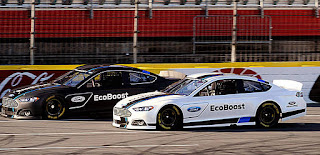
Ford shows off its 2013 Fusion at Charlotte Motor Speedway.
Race fans and manufacturers have been begging NASCAR to run race cars that more closely resemble production vehicles in the Sprint Cup Series.
The first glimmer of that hope becoming a reality appeared at Charlotte Motor Speedway on Tuesday when the new Ford Fusion took to the track. The cars are expected to make their competition debut in the 2013 Daytona 500.
Jamie Allison, director of Ford North America Motorsports, described the reveal as a “seminal moment.”
“This started with a production base, went all the way the other end and came back to this perfect medium of the right balance of performance, competition and design,” Allison said. “For many years, as someone said earlier, we kind of lost our way. This is car racing. The cars on the track need to look like the cars in people’s driveways, and this is what this car is.”
Certainly, stock car racing enthusiasts were turned off by the common template vehicles that were introduced as Dodge re-entered the Cup ranks in 2000. A further bastardization of the car was unveiled as the “Car of Tomorrow” — a concept so despised by fans that NASCAR soon spun the description as the “new car.”
But race fans aren’t naive. Neither are the manufacturers who use NASCAR as a tool to sell vehicles.
Mike Fisher, NASCAR’s managing director of research and development, said it was imperative to fans and manufacturers to improve brand identity.
“They want to see this to enhance their marketing efforts in the sport,” Fisher said. “I think the fans have been clear with both us and the manufacturers, as well. They want stock cars to look a little bit more — a lot more — like the cars they drive on the street. We’ve embraced that effort and have allowed the manufacturers to cut them loose. We defined some common areas and let them fill in the rest.”
What fans will immediately notice is a 4-inch shorter deck lid, with added curvature, and the rake angle of the front windshield. The car’s nose is 2 inches longer and the splitter has been reduced. What hasn’t changed is the chassis or the size of the wheel base.
Sources say NASCAR has a new car test scheduled for Feb. 1, but the sanctioning body would not confirm the date, only that there will be a closed test. But there’s still a ways to go. Ford and Dodge were in the wind tunnel Tuesday, and Toyota and Chevrolet are expected there Thursday. Manufacturers will submit their final cars by Sept. 1.
"The amount of effort that has been put into all of these cars by all of the manufacturers has been incredible,” vice president of competition for NASCAR Robin Pemberton said. “We’ll see. We’re not done. We’re getting the final surfaces because we’ll get the final runoffs from the wind tunnel, but the whole process has been pretty exciting.”
When Pemberton, a former crew chief and program manager at Ford Racing, was asked how long has it been since a true stock car has been on the track, he said, “It’s been forever, probably since the mid- to late ’80s.”
Eddie Wood, co-owner of Wood Brothers Racing, NASCAR’s longest running operation, believes it was a decade or so before that when actual designers were involved with the rollout of a new car.
Garen Nicoghosian, a specialty vehicle design manager, was ecstatic about his role in the planning of the new Fusion race car:
“How can you not be excited about designing a race car — and this is a race car,” said Nicoghosian, a graduate of the Art Center College of Design in Pasadena, Calif.
“I’m surprised we didn’t have this more frequently in the past. I’m fortunate to have been involved in it. The last time this happened, I don’t think I was employed at Ford — it was sometime in the '70s. I was a little kid.
“It’s very important because we get to express ourselves the same way we do in the street cars. . . . It should not stop at the racetrack. Everything we do should have the same ideology. We tried to capture all of those feelings and not just design the car. That was the significance of it. And it’s humbling to know that it’s also a turning point for NASCAR, as well.”
Nicoghosian appreciates “the nimbleness of the car.” He said that while the production and race cars share only one common character line — the bone line on the body, the sphere that defines the door handles just below the beltline — Ford captured the feel of the production car in the race car.
“It was all about the design language,” Nicoghosian said as he walked around the car. “The way we stretched surfaces between the lines and come through with the same care and sensitivity that we have with our production cars. And to allude to a nimbleness and an aggressiveness at the same time.
“It’s not necessarily a brutal machine with garish huge openings and unnecessary roughness. It’s a vehicle that’s sexy and sleek and efficient. It looks aerodynamic — and it is. And it looks technologically advanced. Those were the characteristics that we were trying to capture in the race car.”
Defending Nationwide Series champ Ricky Stenhouse, who won during the first season of the pony cars, joined Roush Fenway Racing teammate Greg Biffle for the first laps on the track with the Fusion.
“Greg and I talked about it after driving around there — it looks cool on the racetrack,” Stenhouse said. “ . . . (Ford) really stepped up their game. This is the future look of NASCAR. The fans loved the Mustang when it came out in the Nationwide Series — and we’ve taken it a step forward with the Fusion. It’s getting back to stock car racing.”
source: foxsports















